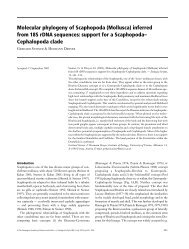Optimum Sample Size to Detect Perturbation Effects: The ...
Optimum Sample Size to Detect Perturbation Effects: The ...
Optimum Sample Size to Detect Perturbation Effects: The ...
Create successful ePaper yourself
Turn your PDF publications into a flip-book with our unique Google optimized e-Paper software.
2 Ortiz<br />
biological population and another different goal could be <strong>to</strong> assess the putative impacts<br />
or perturbations on these populations. <strong>The</strong> abstract and outline of the problem of their<br />
work indicate that the authors' principal objective was more than a simple s<strong>to</strong>ck evaluation.<br />
<strong>The</strong> focus of the study was rather on evaluating optimum management strategies<br />
of a particular marine ecosystem.<br />
Even though Mouillot et al. (1999) used an elegant statistical method, one which is<br />
more appropriate <strong>to</strong> determine population descrip<strong>to</strong>rs such as the distribution pattern, it<br />
is unfortunately an incomplete analysis regarding sample size estimation. Although the<br />
authors planned, a priori, <strong>to</strong> apply an ANOVA design <strong>to</strong> test the working hypothesis,<br />
they made no reference <strong>to</strong> the statistical power analysis; this offers better opportunities<br />
for determining the deleterious effects of putative perturbations on the ecological system<br />
under study (Bernstein & Zalinski, 1983; Toft & Shea, 1983; Rotenberry & Wiens,<br />
1985; Gerrodette, 1987; Andrew & Maps<strong>to</strong>ne, 1987; Green, 1989; Peterman, 1990a,<br />
1990b; Peterman & M'Gonigle, 1992; Schlese & Nelson, 1996; Gray, 1996; Ribic &<br />
Ganio, 1996; Underwood, 1981, 1991, 1993, 1994, 1996, 1997; Sheppard, 1999).<br />
Had the authors explored power analysis theory, they would have recognised that<br />
while the variability (dispersion statistics) is an important fac<strong>to</strong>r <strong>to</strong> estimate the sample<br />
size, the magnitude of the perturbation is even more important. Hence, the questions <strong>to</strong><br />
be addressed are: How large is the disturbance? How many samples are necessary <strong>to</strong><br />
evaluate a putative perturbation?<br />
Moreover, the authors did not introduce the precautionary principle in their analysis.<br />
This principle states that potentially damaging pollution emissions should be reduced<br />
even if there is no scientific evidence <strong>to</strong> prove a causal link between emissions and effects<br />
(Peterman & M'Gonigle, 1992). Even though this concept is related with a particular<br />
type of perturbation (pollution emissions), it is possible <strong>to</strong> use it in a more general<br />
way <strong>to</strong> include other source of perturbations. <strong>The</strong>refore, environmental assessment programmes<br />
deserve a deeper analysis including more concepts and <strong>to</strong>ols, and should not<br />
reduce the issue solely <strong>to</strong> variability coefficients.<br />
<strong>The</strong> principal objectives of the current work are <strong>to</strong> describe the statistical power analysis<br />
strategy and <strong>to</strong> demonstrate, using the results of Mouillot et al. (1999), how its application<br />
helps <strong>to</strong> improve the estimation of the optimum sample size required under a<br />
perturbation working hypothesis.<br />
Proposedmethodology<br />
1. Statistical power analysis<br />
Statistical power analysis constitutes the most suitable procedure for estimating optimal<br />
sample size (n) starting from a particular working hypothesis. <strong>The</strong> focus here is on the<br />
probability of correctly detecting an effect (e.g., of a perturbation), that is, rejecting the<br />
null hypothesis (H 0 ) of no effect and accepting H 1 (Dixon & Massey, 1969; Winer,<br />
1971; Cohen, 1988; Sokal & Rohlf, 1995). <strong>The</strong> power of a test is that probability of<br />
correctly rejecting a false hypothesis, (H 0 ). Power is defined by 1 ± b, b being the probability<br />
of making a Type II error or an incorrect acceptance of H 0 . Power can be calculated<br />
from standard equations and tables (e.g., Dixon & Massey, 1969; Winer, 1971;<br />
Cohen, 1988). It is a function of Type I error (a) or incorrectly rejecting H 0 , the sample








